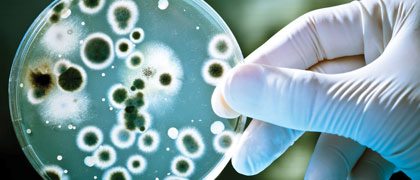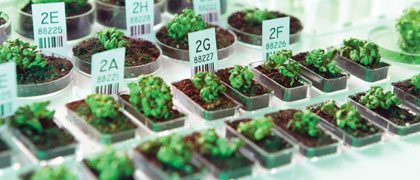Biologicals 101
There’s a great deal of hype within this sector of the market, and with that comes an abundance of terms and new language. This article walks you through the basics.
If you were to ask 10 people for the definition of a biological, you’ll likely get 10 different answers. The science behind biologicals has always been a bit mysterious and the results haven’t always been reliable. However, with today’s advanced science and the technological developments, researchers have a much better understanding of how biologicals work, what differentiates them and how they can best be used.
Biologicals, microbials, biofungicides, bioinsecticides, bioherbicides, biostimulants, biorationals, biofertility, biocontrol, inoculants — all are terms used when discussing biologicals, but how do you decipher what’s what?
According to Monsanto, “agricultural biologicals” is an umbrella term for microbials, plant extracts, beneficial insects and other material that is used by farmers to increase crop health and productivity.
Agricen, a Loveland Products Company, refers to agricultural biologicals as a diverse group of products derived from naturally occurring microorganisms, plant extracts or other organic matter.
Regardless of how one defines biologicals, essentially, everything can be classified into two categories within the biological sphere — biopesticides and biostimulants. Simply put, biopesticides are considered to be a crop protectant, while biostimulants are considered to be a yield enhancer or growth promotant. Both biopesticides and biostimulants are comprised of naturally-derived organisms and can be seed applied.
The difference is that some formulations or applications are comprised of living organisms and these are known as microbials. The products that are not formulated with living organisms, but are naturally-derived, are known as biochemicals.
“Each category is very different and they have different places in the environment for agriculture,” says Gary Harman, chief scientific officer for Advanced Biological Marketing, an Ohio-based developer, manufacturer and distributor of agricultural biologicals.
In Petri dishes, researchers can grow beneficial bacteria, a microbial, which helps defend plants against pests and can promote growth.
What’s a Microbial?
Bacteria, fungi, nematodes, protozoa and viruses — all living organisms — are used in the formulation of microbial products.
Many spore forming and non-spore forming bacteria are known to be effective against a wide spectrum of insects and diseases. According to the Biopesticide Industry Alliance, more than 90 species of naturally occurring, insect-specific bacteria have been isolated. One of the more notable microbial products is bacillus thuringiensis (Bt), which is a spore-forming bacterium that produces toxins that, after ingestion, cause rapid gut paralysis and death of certain insects, especially caterpillars, explains Chris Williamson, a University of Wisconsin-Madison Extension specialist. “Bt is a naturally occurring soil bacterium, but chemical manufacturers have developed a process to formulate it and make it commercially available.
Fungi have complex lifecycles and some are parasitic to various plants and insects. Fungi require specific environmental conditions to proliferate and their means of affecting the target pest are diverse. Meanwhile, nematodes act as insecticides by invading insect larvae through bodily openings and releasing toxic bacteria that kills the host.
And protozoa are single-celled organisms that exist in the water and soil. While most protozoa feed on bacteria and decaying organic matter, a wide range of protozoan species are insect parasites.
More target specific are baculoviruses — a family of naturally occurring viruses known to infect only insects and some related arthropods. Most are so specific in their action that they infect and kill only one or a few species of Lepidoptera larvae.
What’s a Biochemical?
Biochemicals are naturally occurring compounds or synthetically derived compounds that are structurally similar and functionally identical to their naturally occurring counterparts.
They are characterized by their non-toxic mode of action that might affect the growth and development of a pest, its ability to produce or pest ecology. Biochemicals might also have an impact on the growth and development of treated plants, including their post-harvest physiology.
The Biopesticide Industry Alliance divides biochemicals into six categories, which include plant growth regulators, insect growth regulators, organic acids, plant extracts, pheromones and minerals.
Plant growth regulators are hormones that affect major physiological functions of plants and can promote, inhibit or modify the physiological traits of a range of fruit, vegetable, ornamental and agronomic crops. They are used to maximize productivity and quality, improve consistency in production and overcome genetic and abiotic limitations to plant productivity.
Insect growth regulators prevent insects from reaching a reproductive stage, which reduces the expansion of pest populations. When combined with the preservation of beneficial insects and pollinators, insect growth regulators, when directly applied to target pests, can help farmers maximize yield and product quality.
Plant extracts act as insect growth regulators and defend against weed, insect and fungal attacks. Plant extract products can feed deterrents, repellents and confusants. The Biopesticide Industry Alliance also reports that some plant growth extracts provide relief for abiotic stressors, such as heat, drought and salinity. Minerals can be used to create barriers that keep pests from plant tissues or impact water supply, they can deliver physical impacts such as smothering or abrasion and they can act as an inert carrier for companion biopesticides.
Organic acids can be used in a number of ways, a few of which include sanitation and pathogen and algae control. Pheromones are chemical signals that are used to disrupt pest ecology and reduce crop damage.
In the laboratory, scientists experiment with different biostimulant products to test efficacy.
What are Biopesticides?
Biopesticides, also commonly known as biorationals, can be biochemical or microbial.
“Biorationals improve crop quality and are safe to humans and other non-target organisms,” says Ted Melnik of Valent BioSciences Corporation, a leader in the discovery, development manufacturing and commercialization of biorational products. “They present suppliers of quality food and fiber with an added degree of flexibility. Biorationals are used in organic, as well as conventional production systems, and can contribute greatly to the marketability of a crop by creating value that extends all the way to the end-user.”
Melnik says that as more and more companies effectively market food safety and environmental responsibility to consumers, biorational product integration will continue to grow. With the heightened sense of environmental awareness and public concern, biorationals grew in popularity during the late 1990s and are known for having limited or no adverse effects on the environment, Wisconsin’s Williamson says. “They are considered third-generation pesticides that are environmentally sound and closely resemble or are identical to chemicals produced by insects and plants
,” he says. “However, they are quite different from conventional broad-spectrum products. They do not control pests in the same way as most broad-spectrum products. Biorationals are typically target-specific and have little-to-no impact on non-target organisms.”
The U.S. Environmental Protection Agency recognizes three major classes of biopesticides — microbial biopesticides, biochemical pesticides and plant-incorporated protectants.
A common misperception is that biopesticides are meant to replace traditional chemicals, says Biopesticide Industry Alliance Board Chairman Rick Melnick. “They are most effective when used as part of an integrated program,” he says, explaining that biopesticides have several benefits and can be used to manage resistance, enhance crop quality and plant health by reducing plant injury, coordinate harvest with the availability of labor, help growers manage residue levels, preserve beneficial insects and reduce the environmental impact.
What are Biostimulants?
The biostimulant industry is improving agricultural sustainability and soil health, while generating significant new economic growth, writes Brian Cornelious, Agricen director of applied sciences, in a blog post about biostimulants. But the definition of biostimulants is evolving and definitions differ around the world. However, there is general consensus that biostimulants are neither pesticides nor fertilizers.
The European Biostimulant Industry Consortium defines a plant biostimulant as a “material which contain substance(s) and/or micro-organisms whose function, when applied to plants or the rhizosphere, is to stimulate natural processes to benefit nutrient uptake, nutrient use efficiency, tolerance to abiotic stress, and/or crop quality, independently of its nutrient content.” In Europe, unlike the United States, fertilizer is regulated by the European Parliament and the fertilizer laws are being written to include biostimulant products.
Meanwhile, fertilizers in the United States are regulated at the state level. Here, the Biostimulant Coalition, comprised of a group of companies, such as Agricen, BASF, and Marrone Bio Innovations, that cooperate to address regulatory and legislative issues around biostimulants, proposed a slightly different definition: “A biostimulant is a material that, when applied to a plant, seed, soil or growing media — in conjunction with established fertilization plans, enhances the plant’s nutrient use efficiency, or provides other direct or indirect benefits to plant development or stress response.”
But the Association of American Plant Food Control Officials did not agree to define the broad concept of biostimulants. It did, however, develop a process by which biostimulant subcategories can apply for their own respective definitions. For example, a specific fulvic acid definition could be developed that would be defined and placed under the Beneficial Substances category.
The Plant Food Control Officials define a beneficial substance as “any substance or compound other than primary, secondary and micro plant nutrients that can be demonstrated by scientific research to be beneficial to one or more species of plants, when applied exogenously.”
Julie Deering















